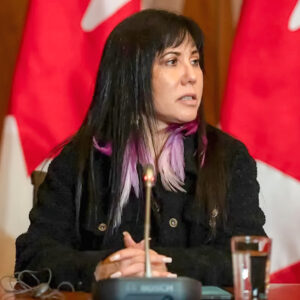
OTTAWA — The Rama Police Service, which serves the Chippewas of Rama First Nation, does not have dedicated funding for forensic and crime investigation units, or to provide aid to victims.
Rama Police Chief Jerel Swamp said the force provides front-line, culturally responsive policing to the community near Orillia, Ont., and like other Indigenous police services, it does so with limited resources.
“We’re the only police services in Canada that is not classified as an essential service,” said Swamp, who is also a vice-president at the First Nations Chiefs of Police Association.
The Liberal government vowed in its speech from the throne this week to speed up the development of a legal framework to recognize First Nations policing as an essential service.
The Liberals had already promised to take action on that shortly after the 2019 election and again in response to Indigenous protests against the Coastal GasLink project in northern B.C.
Then in June, amid widespread calls for police reform following a number of violent police incidents involving Indigenous people across Canada, Public Safety Minister Bill Blair told a House of Commons committee he had begun reaching out to Indigenous communities on how to bring about change.
Indigenous leaders have long been calling on the federal government to deem Indigenous policing an essential service.
“I won’t be happy until I hear two words: royal assent,” Perry Bellegarde, national chief of the Assembly of First Nations, said Wednesday in response to the throne speech.
Public Safety Canada currently funds the services through the First Nations policing program which provides grants to support them in First Nation and Inuit communities.
“The funding that we received from them is inadequate to provide the necessary services that our communities require,” Swamp said.
The federal promise to make First Nations policing an essential service is a step in the right direction, he said.
“It’s been a long struggle,” he said.
Swamp said none of the First Nations police services or their police boards have been consulted on what the legislation needs to include, which he argued is essential.
“We are the experts in First Nations police service,” he said.
“We need to be sitting at the table to be consulted, and to ensure that the legislation that puts in place is going to be working for our communities.”
The government also hasn’t approached the leaders of the Indigenous communities on this issue yet, he said.
Mary-Liz Power, a spokeswoman for Blair, said in a statement that introducing legislation to make Indigenous policing an essential service will require developing a funding framework.
“The work to deliver on this promise is ongoing,” she said.
The First Nations policing program started in 1991 to fund policing agreements between the federal government, provincial or territorial governments, and First Nation or Inuit communities to deliver policing services to these communities.
“There are some First Nation police services that have been in existence for over 50 years, so we are successful in what we do,” Swamp said.
There are two types of policing agreements under the program.
The first are self-administered police service agreements, where a First Nation or Inuit community creates, manages its own police service under its provincial policing legislation.
The second involves standing services, including Ontario Provincial Police and the Royal Canadian Mounted Police, being contracted to provide policing services to a First Nation or Inuit community.
The federal government contributes 52 per cent of the funding to the First Nations policing program and the provincial and territorial governments contribute the rest. It provides policing services for almost 60 per cent of First Nation and Inuit communities.
In 2018-2019, Public Safety Canada spent over $146 million through the program to support 1,322 police officer positions in over 450 First Nation and Inuit communities.
But the funding for the First Nations policing services is not consistent, said Swamp.
“Our funding agreements are for between two to five years at a time,” he said, adding that most other non-Indigenous services, such as the RCMP, is funded for an extended period of time.
The short-term funding makes it harder to plan.
“As leader of the police service, it’s hard for me to create a strategic plan for the future of our community, the future for policing, when I can’t even guarantee the existence of our police service funding,” he said.
Swamp said that despite the limited funding, First Nations police services are effective in investigating violent and other crimes using their limited resources.
“Our front-line officers become more specialized in doing criminal investigation,” he said.
“They can’t pass it off to another officer in a specialized unit, such as a crime officer ? so an officer has to pretty much do the entire investigation from A to Z.”








